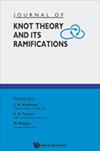将Alexander quandles嵌入到群组中
IF 0.3
4区 数学
Q4 MATHEMATICS
引用次数: 0
摘要
对于任何扭曲共轭量子Q,特别是任何亚历山大量子,存在一个群G,使得Q嵌入到G.1的共轭量子中。可嵌入QUANDLES一个非空集Q,配有二进制运算Q×Q→ Q、 (x,y)7→ 如果x*y满足以下三个公理,则称其为量子:(1)x*x=x(x∈Q),(2)(x*y)*z=(x*z)*(y*z)(x,y,z∈Q→ 由y 7定义的Q→ y*x是双射的。Quantles是由Joyce[7]和Matveev[9]独立引入的。从那时起,半群一直是研究结和环节、杨-巴克斯特方程的集合理论解、Hopf代数和许多其他问题的重要对象。我们参考Nosaka[10]了解更多关于量子的细节。地图f:Q→ 如果半群的Q′满足f(x*y)=f(x)*f(y)(x,y∈Q),则称其为半群同态。给定一个群G,配备有量子运算h*G≔G−1hg的集合G称为G的共轭量子,用Conj(G)表示。如果存在群G和内射半群同态Q,则半群Q称为可嵌入→ 共轭(G)。并非所有的量子都是可嵌入的(见§2的底部)。Bardakov Dey Singh在他们的论文[2]中提出了一个问题“对于哪个量子X,存在一个群G,使得X嵌入共轭量子共轭(G)中?”[2],问题3.1],并证明了与不定点自由对合相关的Alexander半量是可嵌入的[2,命题3.2]。以下是作者已知的可嵌入半量的列表:(1)自由半量和自由n半量(Joyce[7,定理4.1和推论10.3]),(2)交换半量、拉丁半量和简单半量(Bardakov-Nasybullov[3,§5]),(3)核心量子(Bergman[4,(6.5)]),和(4)与不动点自由自同构相关的广义亚历山大量子(Dhanwani-Raundal-Singh[5],3.12]命题)。在这篇短文中,我们将证明包括所有亚历山大量子的扭曲共轭量子是可嵌入的,从而推广了Bardakov-Dey-Singh的上述结果。2020数学学科分类。初级20N02;二级08A05、57K10。本文章由计算机程序翻译,如有差异,请以英文原文为准。
Embedding Alexander quandles into groups
For any twisted conjugate quandle Q, and in particular any Alexander quandle, there exists a group G such that Q is embedded into the conjugation quandle of G. 1. EMBEDDABLE QUANDLES A non-empty set Q equipped with a binary operation Q×Q → Q, (x,y) 7→ x∗ y is called a quandle if it satisfies the following three axioms: (1) x∗ x = x (x ∈ Q), (2) (x∗ y)∗ z = (x∗ z)∗ (y∗ z) (x,y,z ∈ Q), (3) For all x ∈ Q, the map Sx : Q → Q defined by y 7→ y∗ x is bijective. Quandles were introduced independently by Joyce [7] and Matveev [9]. Since then, quandles have been important objects in the study of knots and links, set-theoretical solutions of the Yang-Baxter equation, Hopf algebras and many others. We refer to Nosaka [10] for further details of quandles. A map f : Q → Q′ of quandles is called a quandle homomorphism if it satisfies f (x ∗ y) = f (x) ∗ f (y) (x,y ∈ Q). Given a group G, the set G equipped with a quandle operation h ∗ g ≔ g−1hg is called the conjugation quandle of G and is denoted by Conj(G). A quandle Q is called embeddable if there exists a group G and an injective quandle homomorphism Q → Conj(G). Not all quandles are embeddable (see the bottom of §2). In their paper [2], Bardakov-Dey-Singh proposed the question “For which quandles X does there exists a group G such that X embeds in the conjugation quandle Conj(G)?” [2, Question 3.1], and proved that Alexander quandles associated with fixed-point free involutions are embeddable [2, Proposition 3.2]. The following is a list of embeddable quandles of which the author is aware: (1) free quandles and free n-quandles (Joyce [7, Theorem 4.1 and Corollary 10.3]), (2) commutative quandles, latin quandles and simple quandles (Bardakov-Nasybullov [3, §5]), (3) core quandles (Bergman [4, (6.5)]), and (4) generalized Alexander quandles associated with fixed-point free automorphisms (Dhanwani-Raundal-Singh [5, Proposition 3.12]). In this short note, we will show that twisted conjugation quandles, which include all Alexander quandles, are embeddable, thereby generalize the aforementioned result of Bardakov-Dey-Singh. 2020 Mathematics Subject Classification. Primary 20N02; Secondary 08A05, 57K10.
求助全文
通过发布文献求助,成功后即可免费获取论文全文。
去求助
来源期刊
CiteScore
0.80
自引率
40.00%
发文量
127
审稿时长
4-8 weeks
期刊介绍:
This Journal is intended as a forum for new developments in knot theory, particularly developments that create connections between knot theory and other aspects of mathematics and natural science. Our stance is interdisciplinary due to the nature of the subject. Knot theory as a core mathematical discipline is subject to many forms of generalization (virtual knots and links, higher-dimensional knots, knots and links in other manifolds, non-spherical knots, recursive systems analogous to knotting). Knots live in a wider mathematical framework (classification of three and higher dimensional manifolds, statistical mechanics and quantum theory, quantum groups, combinatorics of Gauss codes, combinatorics, algorithms and computational complexity, category theory and categorification of topological and algebraic structures, algebraic topology, topological quantum field theories).
Papers that will be published include:
-new research in the theory of knots and links, and their applications;
-new research in related fields;
-tutorial and review papers.
With this Journal, we hope to serve well researchers in knot theory and related areas of topology, researchers using knot theory in their work, and scientists interested in becoming informed about current work in the theory of knots and its ramifications.

 求助内容:
求助内容: 应助结果提醒方式:
应助结果提醒方式:


